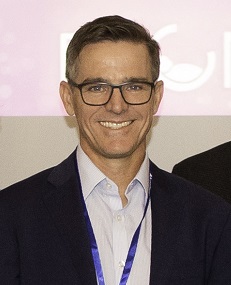Interview with Associate Professor Luke Jardine
Luke Jardine works as Staff Specialist Neonatology at Mater Hospital, Brisbane, Australia, Division of Neonatology. He is the author of numerous research publications in the field of neonatology with a focus on preterm birth and neonatal intensive care.
Professor Jardine, respiratory distress syndrome (RDS) is a quite serious complication mainly in preterm babies, can you give us a little more background on the disease and explain which babies are primarily at risk?
RDS is caused by surfactant deficiency. Surfactant is a protein made in the lungs that reduces the surface tension and enables the lungs to expand more easily. Natural surfactant production increases as babies get close to term. Premature babies may not have enough surfactant at birth and therefore can develop respiratory distress.
As preterm birth is the highest risk factor, what can be done if a pregnant woman is about to give birth to a preterm baby to avoid RDS?
Giving antenatal corticosteroids to mothers prior to their delivery is the best way to decrease the risk of RDS. Antenatal corticosteroids increase the natural production of surfactant from the Type 2 pneumonocytes in the lung. To get the most benefit from antenatal steroids the mother requires two daily doses and the baby should be delivered 24 hours after the second dose. However, even if delivery of the baby can’t wait that long, antenatal corticosteroids should be given as soon as possible.

Luc Jardine (c) photo EFCNI
If a baby is born preterm and is diagnosed with RDS, what are the main therapeutic measures in this emergency situation?
Initially we will try to stabilise the baby with Non-Invasive Respiratory support (e.g. CPAP, HFNC or NIPPV)*. If the baby has poor respiratory effort, the baby may require intubation. If a baby is intubated, we will give surfactant via their endotracheal tube. If a baby is breathing with the help of one of the non-invasive methods of respiratory support, we can give the surfactant via a thin catheter passed directly between the vocal cords (LISA – Less Invasive Surfactant Administration or MIST – Minimally Invasive Surfactant Treatment) or they can be briefly intubated, given their surfactant and then extubated (INSURE), or they can be intubated, given surfactant and remain intubated (traditional approach).
What are the main application methods for surfactant and can you briefly explain what, in your view, are the advantages and disadvantages of the different methods?
As mentioned above the two main methods are to give surfactant via an endotracheal tube (traditional approach or INSURE) or via a small catheter passed between the vocal cords to a baby who is spontaneously breathing (MIST or LISA). The evidence from meta-analysis is now suggesting that the MIST/LISA approach is best for babies. There are two other methods which have been used to give surfactant, the first is via a pharyngeal bolus which is administered into the upper airway and then pushed into the lung using positive pressure ventilation with a mask. The second method is to administer it with a nebuliser to babies who are receiving non-invasive respiratory support.
You and your colleagues are currently investigating a new surfactant delivery device involving a new nebuliser. Although the trials are still ongoing, can you tell us something about it?
The current proven methods of surfactant administration require the baby to have a laryngoscope inserted and a tube (either ETT or thin catheter) passed through the vocal cords. It can sometimes be difficult to do this especially if it is not something the clinician does regularly. There is considerable debate about how painful the procedure is and should the baby receive pre-medications (including paralysis and sedation). Despite the best efforts of the clinicians occasionally the surfactant is not administered to the lungs and ends up being administered into the oesophagus where it provides no benefit.
The potential benefit of nebulised surfactant is that the baby can remain on their non-invasive respiratory support and not have a laryngoscope placed into the pharynx (+/- the medications). It may therefore be very useful in smaller centres where there is limited experience in administering surfactant. Nebulised surfactant has been trialled previously however with the older nebulisers most of the surfactant was lost to the environment or deposited in the pharynx and never actually reached the lungs. The new mesh membrane nebulisers form very small particles which reach the distal alveoli, and synchronising the delivery of surfactant with the baby’s breathing means much less is wasted into the environment.
Our initial studies have shown that nebulised surfactant is safe and well tolerated by babies. We now need to do larger studies to show that it decreases the need for babies to have surfactant directly administered to their lungs via an endotracheal tube or thin catheter.
The mortality rate of preterm infants decreased dramatically thanks to surfactant therapy and advanced application methods. However, many very preterm infants who survive thanks to surfactant therapy develop a disease called bronchopulmonary dysplasia (BPD), a chronic lung disease. How can we help those very preterm babies?
BPD is a complex problem that has many contributing factors. One of the contributing factors is mechanical ventilation. We therefore believe that if we can avoid mechanical ventilation and maintain more babies on the non-invasive forms of respiratory support then ultimately we will reduce the incidence of BPD.
Professor Jardine, many thanks for this interview!
* CPAP = Continuous positive airway pressure
HFNC = High-flow nasal cannula
NIPPV = Non-invasive positive-pressure ventilation
This interview is kindly supported by Lyomark Pharma GmbH.

